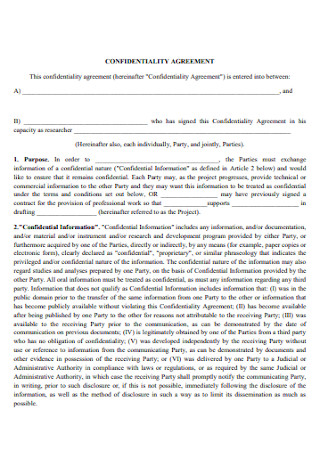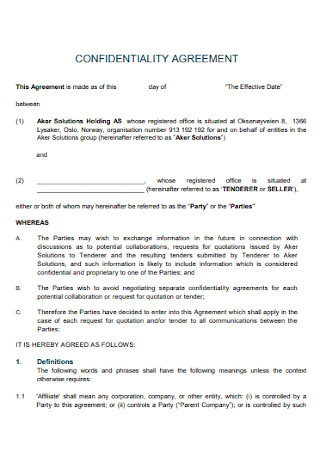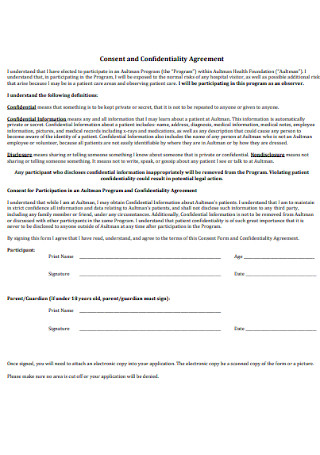A Sales Agreement is a vital legal document that outlines the terms and conditions of a transaction between a buyer and a seller. It defines the rights, obligations, and…
continue reading
44+ Sample Confidentiality Agreement Templates
-

Sample Confidentiality Agreement Template
download now -

Confidentiality and Non Disclosure Agreement
download now -

Employee Confidentiality Agreement
download now -

Very Short Confidentiality Agreement
download now -

Mutual Confidentiality Agreement
download now -

Basic Confidentiality Agreement Template
download now -

Three Way Confidentiality Agreement
download now -

Company Project Confidentiality Agreement
download now -

Model Confidentiality Agreement
download now -

Confidentiality Agreement for Non Employees
download now -

Two-Way Confidentiality Agreement
download now -

Confidentiality Agreement Form
download now -

Partner Confidentiality Agreement
download now -

Boards of Directors Confidentiality Agreement
download now -

Employee Confidentiality Agreement Example
download now -

Consent and Confidentiality Agreement
download now -

Computer Access Confidentiality Agreement
download now -

Sample Confidentiality Agreements for Clients
download now -

Confidentiality Statement Agreement
download now -

Confidentiality Agreement Checklist
download now -

Confidentiality Agreement Format
download now -

Confidentiality Agreement and Confidentiality Agreement
download now -

Site License and Confidentiality Agreement
download now -

Confidentiality Agreement for Agent
download now -

Certification and Confidentiality Agreement
download now -

University of Access and Confidentiality Agreement
download now -

Open Season Confidentiality Agreement
download now -

Information Confidentiality Agreement
download now -

Client Confidentiality Agreement
download now -

Time Limits in Confidentiality Agreements
download now -

Mediation Confidentiality Agreement
download now -

Overview of Confidentiality Agreement
download now -

Student Employee Confidentiality Agreement
download now -

Formal Confidentiality Agreement Template
download now -

Confidentiality Agreements and Due Diligence
download now -

Confidentiality Agreement for Third Party Suppliers
download now -

Confidentiality Agreement for Interns
download now -

Enterprise Risk Management Confidentiality Agreement
download now -

Information Technology Confidentiality Agreement
download now -

Confidentiality Agreement for Workforce Members
download now -

Family Client Confidentiality Agreement
download now -

Confidentiality Agreement for Faculty
download now -

Information Seurity and Confidentiality Agreement
download now -

Printable Confidentiality Agreement Template
download now -

Minor Works Confidentiality Agreement
download now
What Is a Confidentiality Agreement?
First of all, the word confidential means anything to be kept private or secret. By adding that word to an agreement, you form a binding arrangement where parties are entrusted with restricted information. Thus, the confidentiality agreement (CA) refers to any legally binding contract, particularly between employers and employees, where no party should disclose any detail considered confidential. According to Investopedia, the CA is widely used among sensitive business information and corporate knowledge, which other parties must not know about. Also, the term can be identified as a non-disclosure agreement (NDA).

Did you know that there were around 1,473 data breaches in the US back in 2019?
More so, the said data breach unveiled around 164.68 million private records.
Meanwhile, Digital Guardian confirmed via Forbes that ten years before, approximately 300 and more data breaches ended up having 100,000 records stolen.
Secrets Revealed: When to Use Confidentiality Agreements
It is a known fact that CA or NDA helps maintain an effective arrangement for privacy and confidentiality between any business owner and an employee. But when do you exactly need that binding agreement? Some common examples of facets worth protecting are trade secrets, discoveries, business methods, inventions, and other relevant data. To be more specific, here are samples of when to depend on a confidentiality agreement:
Mutual vs. Non-Mutual CA
What else is essential in a confidentiality agreement? Signatures. A signed agreement proves that the parties mentioned in the form have read and understood its content. However, how many signatures are present in a document varies since it is considered as unilateral, bilateral, or multilateral. Unilateral refers to having one party signed only. If two parties signed it, then that is bilateral. On the other hand, multilateral refers to involving numerous parties or a whole group that has entries for information to disclose. But what happens when no mutual agreement occurs? Take a look at the difference between a mutual and a non-mutual CA:
Mutual Confidentiality Agreement
By saying that the confidentiality agreement is mutual, it means sending and receiving confidential information occurs to both parties. In fact, mutual CA is much safer than the other format because the two parties have something to lose when private details leak. In ensuring both secrets remain disclosed, both sides must adhere to their deal. An example is a celebrity CA. Celebrities easily spark media and public attention. In making sure this celebrity retains his or her privacy, a mutual CA with the manager is helpful wherein the celebrity also has information to disclose about the manager. Work this example out by forming an artist management agreement.
Non-Mutual Confidentiality Agreement
Non-mutual or one-sided confidentiality contract or agreement happens when the arrangement only has one party sharing any confidential information with another side. Hence, the other side, aware of the secret, has nothing to lose because he or she does not have any restricted detail that can be harmful. It is vital for the disclosing party to ensure that sensitive information does not have to spread through an agreement. Therefore, having each side to share private information is not an example of a one-sided CA.
How to Create an Acceptable Confidentiality Agreement
Statista taught us that out of the 1,473 American data breaches in 2019; it exposed approximately 164.68 million private records. Imagine how dangerous it can be to have any private, sensitive, or confidential information disclosed just like that. With that many breaches, statistics might increase when your business does not have strict terms regarding the confidentiality agreement too. To avoid such an issue, forming the right CA is the key. How do you do this? Follow these steps in making an acceptable CA:
Step 1: Recognize Every Party
Any agreement should begin with a straightforward description of introducing the parties. By this, identify who gives out the confidential details (disclosing party) and who also receives it (recipient). An easy way of establishing that is to mention the full names, profession, contact information, company position, and other details to recognize them. As much as possible, do your part in gathering the complete and accurate set of identification details, or this segment would fail already. For the multilateral CA, include the background of the affiliated companies, partners, and other third parties.
Step 2: Define the Confidential Information
What is the disclosing party trying to protect in the first place? Expound that on this document. You can make it less wordy, too, by being succinct. With that said, specify what the items to protect are—a healthcare discovery, personal secret, school budget, business model, and so much more. Aside from identifying this, explain why the said detail is confidential. Consider how someone’s reputation could be affected when a secret discloses, perhaps. Moreover, help the parties understand the value of the information. Merely saying that it is crucial without any further explanation makes it questionable only.
Step 3: Discuss the Obligations of the Receiving Party
The recipients have roles to fulfill upon signing the agreement. And such responsibilities need to be enumerated on the sheet. Besides telling everyone to protect a secret, be more specific by telling them how to protect it instead. For example, inform the recipient about keeping his or her mouth shut when a particularly sensitive topic arises in specific conversations. Also, provide what they are allowed to say and not to say as this prevents confusion in disseminating any detail. Furthermore, tell them the duration of how long secrets remain restricted as it may be allowed to disclose at some point.
Step 4: Set the Terms and Conditions
Do not forget that agreements include serious policies too. By setting standards, conditions, and special instructions in the form, parties finally learn what is allowed and prohibited from the whole agreement. Incorporating the state laws is encouraged here too to prove that the rules go according to the law. Furthermore, remind the parties about what consequences they undergo when they break any rule as a reminder that they have to face penalties in violating the enterprise’s policy.
Step 5: Note the Termination and Dispute Clauses
Prosecuting theft of secrets is worth preparing for. We learned that ten years back, there were already 300+ data breaches involving 100,000+ stolen records. And any possible breach might take place with the terms stipulated in the sheet. To further lessen the chances of failure, it is essential to note down the dispute and termination clauses inside. Planning involves thinking ahead of other possibilities anyway. In case an employee or any party decides to cancel the whole project, how to deal with them should be clearly defined in the penalty clause. Regard this entire segment as a contingency plan to receive compensation and other ways to solve unforeseen situations.
FAQs
What is the difference between a non-disclosure agreement and a confidentiality agreement?
Although NDA and CA are interchangeable, they are slightly different in particular circumstances. Most people use a confidentiality agreement when a higher degree of secrecy is needed, while an NDA implies the parties not to disclose any personal or private information to anyone. Nevertheless, employers use a confidentiality agreement more often on commercially sensitive information. An NDA is used for startup situations or if there’s a third party involved.
What happens when you break a confidentiality agreement?
Breaking such an agreement is not exactly a heinous crime. However, failing to observe the stipulations under CA could have one to be sued. Paying financial damages and other related fees may follow too.
How long can a confidentiality agreement last?
The schedule or duration of how long the agreement lasts depends on what is stated under the document. Albeit the range varies, the standard use for CA typically goes from one up to five years. Nonetheless, it depends on the transaction’s nature and condition.
Already convinced that you can keep secrets like a pro? Think again. Even when you master the art of keeping certain information disclosed, how sure are you that the rest of the team is just as good? This idea brings us back to why the confidentiality agreement plays a significant role in businesses, plans, and projects involving confidential matters. Precautionary measures are needed to safeguard restricted details before anything undesirable happens. Protect the future now by downloading our collection of CA templates as a start.

